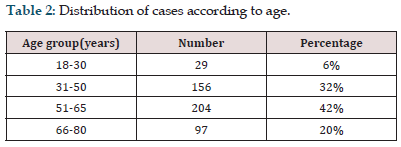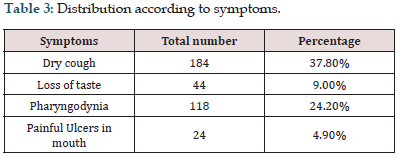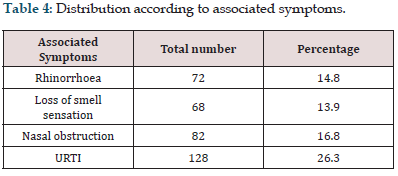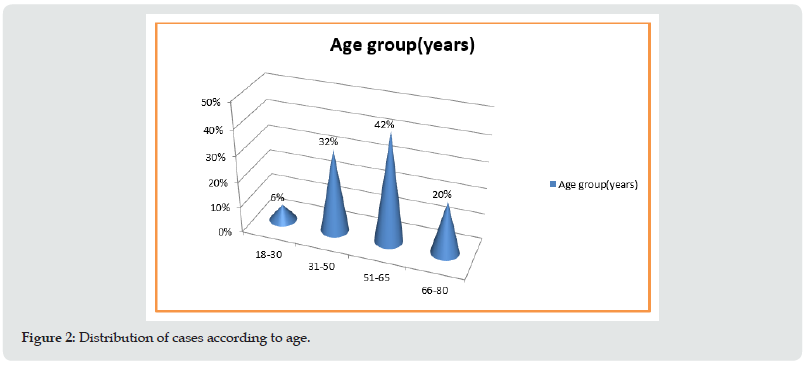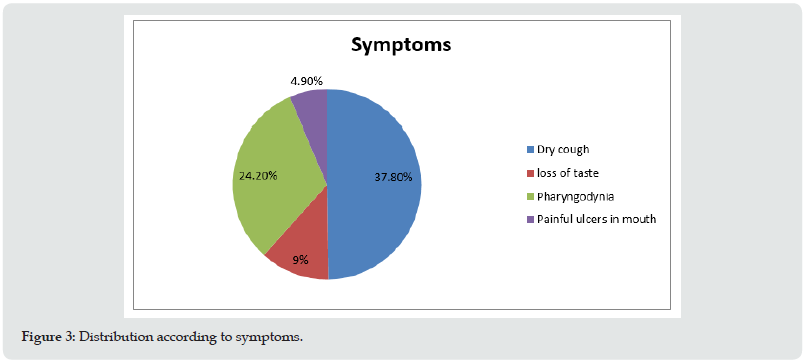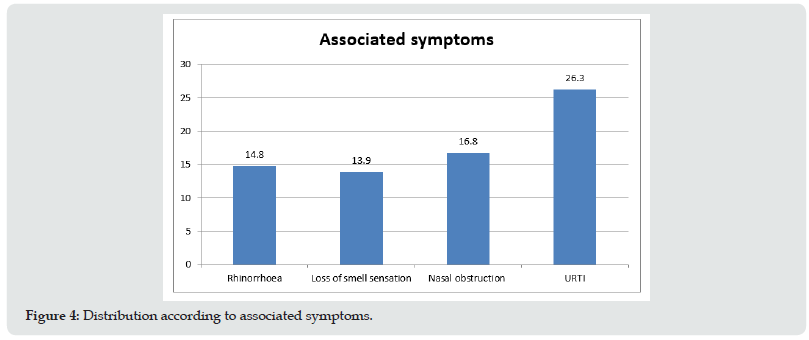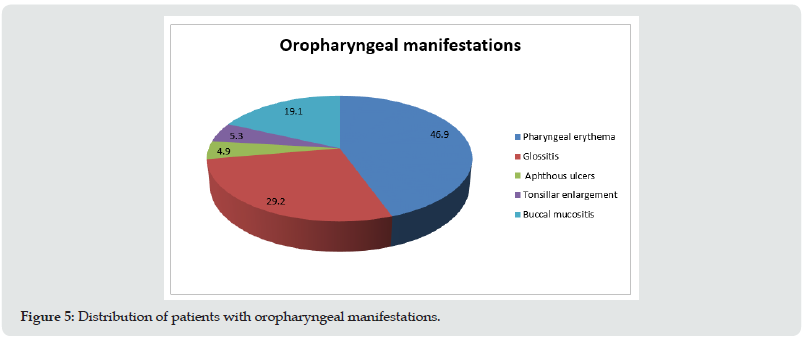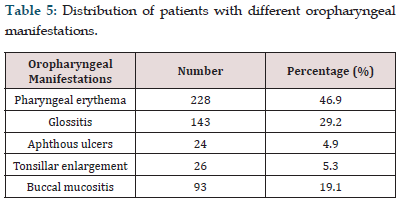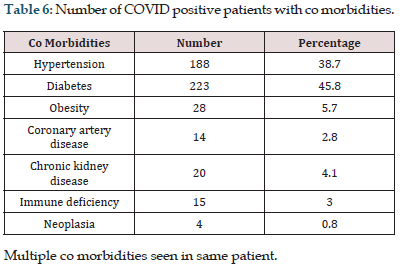
Lupine Publishers Group
Lupine Publishers
Menu
ISSN: 2641-1709
Research Article(ISSN: 2641-1709) 
Oropharyngeal Manifestations in Covid-19 Patients Volume 5 - Issue 4
Harshavardhan Annigeri1, Bandiahanapalya Narasappa Yogesh1*, Borlingegowda Viswanatha2, Anudeep C kode3 and Monisha R3
- 1Senior Residents, Department of Otorhinolaryngology, Bangalore Medical College and Research Institute, India
- 2Professor and Head, Department of Otorhinolaryngology, Bangalore Medical College and Research Institute, India
- 3Post graduates, Department of Otorhinolaryngology, Bangalore Medical College and Research Institute, India
Received: December 18, 2020 Published: January 06, 2021
Corresponding author: Yogesh Bandiahanapalya Narasappa, Professor and Head, Department of Otorhinolaryngology, Bangalore Medical College and Research Institute, Bengaluru, India
DOI: 10.32474/SJO.2021.05.000220
Abstract
Introduction: Coronavirus disease 2019 (COVID-19) an infectious disease was first identified in December 2019 in Wuhan, China, caused by severe acute respiratory syndrome corona virus 2 (SARS-CoV-2). It was considered by the World Health Organization (WHO) as a pandemic. Oropharyngeal manifestations like mucositis, glossitis, pharyngitis, tonsillar enlargement associated with COVID19 show inconsistency in their presentations. Hence the study aims at the early identification and better management of the oropharyngeal manifestations.
Aims and Objectives This study is to detect, analyze and to determine the prevalence of the different oropharyngeal manifestations reported in COVID19 positive patients
Materials: Patients who are diagnosed with COVID 19 using RT-PCR method, were assessed for symptoms and signs of oropharyngeal manifestations using standard questionnaires.
Method: Cross sectional study.
Results: Out of 486 COVID positive patients’ males outnumbered female patients. The highest number of oropharyngeal manifestations was seen in patients in the age group of 51-65 years (42%). Least age and highest age of the patient encountered in this study was 19 years and 78 years, respectively. Dry cough (37.8%) was the most common symptom followed by pharyngodynia (24.2%) with the least common being painful ulcers in mouth (4.9%). Among 486 COVID positive patients’ pharyngeal erythema(46.9%) was the most common manifestation followed by glossitis,(29.2%) and buccal mucositis(19.1%). Aphthous ulcer (4.9%) was the least common manifestation. In our study nearly 45.8% (223 in number) of patients had history of diabetes followed by hypertension in 38.7% (188 numbers) as the co morbidity found in COVID positive patients. Neoplasia was the least common co morbidity observed.
Conclusion: Oropharyngeal manifestations for COVID-19 are not common as fever and cough. But a universal questionnaire using well-defined COVID-19 manifestations is needed to make the COVID-19 data precisely defined, complete and homogenous and to differentiate from the etiology other than COVID 19.
Keywords:Oropharyngeal; COVID-19; manifestations
Introduction
The Severe Acute Respiratory Syndrome Corona virus 2 (SARSCoV- 2), firstly known as novel Corona virus (2019-nCoV), started in Wuhan in China in December 2019, having dramatic spread all over the world [1,2]. The COVID-19 is part of the species of the SARS-related corona viruses that have led to previous epidemics over the last two decades such as SARS-CoV in 2002–2003 in China and the Middle East Respiratory Syndrome (MERS-CoV) in 2012–2013 in Saudi Arabia [3,4]. The oro-pharyngeal health of COVID-19 patients can be affected by any infections; there is still doubt whether these manifestations could be a typical pattern resulting from the direct viral infection or not. Oro pharyngeal lesions can result from the systemic deterioration, considering the possibility of opportunistic infections and also adverse reactions of treatments. Therefore, the range of COVID- 19 manifestations in the oral cavity and pharynx has been considered to be of broad and current interest [5]. Immuno-inflammatory processes have been associated with hyper-pigmentation of melanin from the oral mucosa. Inflammatory mediators, such as histamine and arachidonic acid metabolites trigger melanogenesis and inflammatory cytokines such as TNF-α and IL-1α induce the secretion of melanogenic agents (SCF, HGF, bFGF, endothelin) by keratinocytes. Due to the use of intensified therapeutic methods possibly aggravated by SARS-CoV-2, an increase in cases with oro pharyngeal symptoms/conditions, dental-oral problems associated with soft tissues, and saliva production (dry mouth) as side effects could be predicted, even after recovering from COVID-19(7). Thus, the aim of the current work was to detect and discuss the different oro-pharyngeal manifestations that were reported in COVID-19 positive patients.
Methods
This cross-sectional study was conducted during the COVID-19 pandemic era from September 2020 to October 2020 in designated COVID 19 hospital. We included for the study those who were admitted in the hospital for being COVID-19 positive laboratory confirmed patients. They were examined for various oropharyngeal manifestations with all precautions after obtaining informed written consent using standard questionnaires. A detailed history of various oropharyngeal symptoms noted, examination done and documented, SPSS software was used to analyze the data.
Inclusion criteria
a) Patients with > 18 years of age with positive COVID 19 test.
b) Patients having oropharyngeal symptoms.
Exclusion criteria
a) Age < 18 years old,
b) No confirmed positive PCR test result.
c) Pre-existing oro- pharyngeal manifestations.
d) Severe respiratory failure or treatment in the intensive care units.
Results
(Table 1) Out of 486 patients male patients account for 58.5% (284) out numbering the female patients which accounts for 41.5% (202) (Figure 1). (Table 2) The highest number of oropharyngeal manifestations was seen in patients in the age group 51-65 years (42%). Least age of the patient encountered in this study was a 19- year male patient. Highest age of the patient in this study was a 78- year male patient (Figure 2). (Table 3) Most common symptom of patient with oropharyngeal manifestations in covid positive patients was dry cough (37.8%), followed by pharyngodynia (24.2%). Least common symptom was painful ulcers in mouth (4.9%). Almost all patients presented with multiple symptoms (Figure 3). (Table 4) In our study 128 patients had URTI as associated symptom followed by nasal obstruction (82 patients), rhinorrhoea (72 patients) among 486 patients (Figure 4). (Table 5) Among 486 COVID positive pharyngeal erythema( 46.9%) was the most common manifestation followed by glossitis,(29.2%) and buccal mucositis(19.1%), aphthous ulcer(4.9%) is the least presentation (Figure 5). (Table 6) In our study nearly 45.8% (223) of patients had history of diabetes as a co morbidity following hypertension 38.7% (188) being the next most common co morbidity found in COVID positive patients. Neoplasia was the least common co morbidity observed (Figure 6).
Multiple manifestations seen in same patient
Multiple co morbidities seen in same patient.
Discussion
Current research shows that coronavirus damage to respiratory and other organs could be related to the distribution of angiotensinconverting enzyme receptors in the human system. Therefore, cells with ACE2 receptor distribution may become host cells for the virus and further cause inflammatory reactions in related organs and tissues, such as the tongue mucosa. The COVID-19 acute infection, along with associated therapeutic measures, could potentially contribute to negative outcomes concerning oral health, likely leading to various opportunistic fungal infections, recurrent oral herpes simplex virus (HSV-1) infection, oral unspecific ulcerations, fixed drug eruptions, dysgeusia, xerostomia linked to decreased salivary flow, ulcerations and gingivitis as a result of the impaired immune system and/or susceptible oral mucosa [5]. The study conducted by Tabish M et al showed that out of 160 symptomatic COVID 19 positive patients, 64 (40%) were females, while 96 (60%) were males, majority (44.3%) of cases belonged to the age group of 21 to 40 years followed by 41 to 60 years (30%). The most common ENT symptom found was dry cough, (86.8%) and fever, (76%). 55% of patients gave history of sore throat which is similar to our study [6]. Study done by Mohammed M E et al. showed that the most common oropharyngeal manifestation for COVID-19 was sore throat (11.3%) [7] which is similar to present study. Study by Nanshan Chen et al showed that out of the 99 patients, the average age of the patients was 55·5 years, including 67 male and 32 female. Nearly 51% of patients had history of chronic diseases. Patients had clinical manifestations of fever (83% of patients), cough (82% of patients), shortness of breath (31% of patients), muscle ache (11% of patients), sore throat (5% of patients), rhinorrhoea ( 4% of patients) [8] which is almost similar to current study.
Conclusion
Oropharyngeal manifestations for COVID-19 are not common as fever and cough. But a universal questionnaire using well-defined COVID-19 manifestations is needed to make the COVID-19 data precisely defined, complete and homogenous and to differentiate from the etiology other than COVID 19.
References
- Xia W, Shao J, Guo Y, Peng X, Li Z, et al. (2020) Clinical and CT features in pediatric patients with COVID-19 infection: different points from adults. Pediatr Pulmonol 55(5): 1169-1174.
- Cucinotta D, Vanelli M (2020) WHO declares COVID-19 a pandemic Acta bio-medica: Atenei Parmensis 91(1): 157-160.
- Drosten C, Günther S, Preiser W, Van Der Werf S, Brodt HR, et al. (2003) Identification of a novel coronavirus in patients with severe acute respiratory syndrome. N Engl J Med 348(20): 1967-1976.
- De Wit E, van Doremalen N, Falzarano D, Munster VJ (2016) SARS and MERS: recent insights into emerging coronaviruses. Nat Rev Microbiol 14(8): 523.
- Amorim Dos Santos J, Normando AGC, Carvalho da Silva RL (2020) Oral mucosal lesions in a COVID-19 patient: New signs or secondary manifestations? Int J Infect Dis 97: 326-328.
- Maqbool T, Mehta KS, Mustafa H (2020) How a COVID-19 positive patient can present to an otolaryngologist, a variable presentation: what not to miss? Int J Otorhinolaryngol Head Neck Surg 6: 1517-1519.
- El-Anwar MW, Elzayat S, Fouad YA (2020) ENT manifestation in COVID-19 patients. Auris Nasus Larynx 47(4): 559-564.
- Chen N, Zhou M, Dong X, Qu J, Gong F, et al. (2020) Epidemiological and clinical characteristics of 99 cases of 2019 novel corona virus pneumonia in Wuhan, China: a descriptive study. The Lancet 395(10223): 507-513.

Top Editors
-

Mark E Smith
Bio chemistry
University of Texas Medical Branch, USA -

Lawrence A Presley
Department of Criminal Justice
Liberty University, USA -

Thomas W Miller
Department of Psychiatry
University of Kentucky, USA -

Gjumrakch Aliev
Department of Medicine
Gally International Biomedical Research & Consulting LLC, USA -

Christopher Bryant
Department of Urbanisation and Agricultural
Montreal university, USA -

Robert William Frare
Oral & Maxillofacial Pathology
New York University, USA -

Rudolph Modesto Navari
Gastroenterology and Hepatology
University of Alabama, UK -

Andrew Hague
Department of Medicine
Universities of Bradford, UK -

George Gregory Buttigieg
Maltese College of Obstetrics and Gynaecology, Europe -

Chen-Hsiung Yeh
Oncology
Circulogene Theranostics, England -
.png)
Emilio Bucio-Carrillo
Radiation Chemistry
National University of Mexico, USA -
.jpg)
Casey J Grenier
Analytical Chemistry
Wentworth Institute of Technology, USA -
Hany Atalah
Minimally Invasive Surgery
Mercer University school of Medicine, USA -

Abu-Hussein Muhamad
Pediatric Dentistry
University of Athens , Greece

The annual scholar awards from Lupine Publishers honor a selected number Read More...





